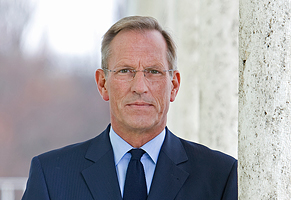Every fair has its labyrinth where people get lost in the maze of glass and mirrors. Everyone thinks they know the way out. For a moment, you are far away from the everyday world, and it’s all a lot of fun. But at some point everyone just wants out.
Europe’s economic situation is a little like a trip through the labyrinth. Decades of excessive government debt has brought us there. It paid for a lifestyle beyond the means of the people. Then came the banking, global economic and debt crisis. Attempts to find a way out of this thicket came fast and furious. Crisis management was needed everywhere, including for the euro.
Since then, the rescue policies have made some progress. Yield spreads between Germany and the most beleaguered countries have shrunk significantly in recent months. The markets responded to the drama around Italy forming a government and the bumpy rescue of Cyprus much more smoothly than would have been possible a year before.
But we are still in the labyrinth – a euro world with huge debts, where lots of countries are struggling with a massive economic downturn and unemployment is growing ominously. The high youth unemployment is particularly worrying.
It is not even clear that the measures up to now will free the currency union from this malaise and establish itself once again as a place of stability and prosperity. The calm in the markets comes mainly thanks to the expansive fiscal policy of the European Central Bank (ECB) which can’t be a permanent situation. The effects on savers have already reached the tolerance limit. If we really want to get out of the fun house, we need the determination to drive forward European integration. Not least in order to return to a state of fiscal normality.
Anyone who is now calling for the government to stop getting its house in order structurally an reduce the debt burden is being irresponsible. The demand for an end to austerity amid aging societies is nothing less than admitting: We want to borrow for a comfortable life today and leave it to the next generation to pick up the tab.
Calling for Europe to drive economic growth with money from even more debt or higher taxes only takes us deeper into the labyrinth. We see that in Japan which has been following this course of fiscal policy unsuccessfully for 20 years. On the other hand, the claim that Europe is cost-cutting itself into oblivion is not entirely accurate: After all, government spending in the euro region has grown over the last three years by 3.6 percent or 167 billion euros.
So we need to keep reducing spending without letup. Even countries like Italy and Spain are only able to finance their debts through (indirect) aid from European institutions. This artificial drip-feed by the ESM needs to have an expiration date. Prolonged indefinitely, it would mean a protracted insolvency, and the euro would break apart under an unlimited shared liability. So there is no room for debt reduction and stimulus to be played off against each other as political positions.
However, there are ways to cut spending that generate impulses for businesses to grow, namely by reducing the amount of government and bureaucracy and pushing structural reforms that free up the rigid labor, capital and product markets. If governments can reign in their hunger for debt and new space emerges for businesses to act, the savers in an economy can also put their money to work more productively.
For their part, companies need access to capital so they can get new business models up and running. This access is stymied in many euro countries, which is hampering growth. In order to fix that flaw, we need to introduce the European banking union. It should be launched with a strong, unified supervisor that orchestrates recapitalization measures, forces sector consolidation and generally restructures the banking system in such a way that it once again is trusted and drives growth.
However, this path toward consolidation and growth will only lead to wealth and social stability if Euroland makes a quantum leap in integration. It can’t work without a shared sense of policy and unified rules in the currency union. When the stability of the entire system is under threat, effective measures need to be taken, meaning they also need to affect national fiscal and economic policy – as bitter as that may be for proponents of national self-determination. Longing for a Europe as a place of prosperity and at the same time insisting on national sovereignty in all issues of European relevance – it just doesn’t work.
Despite all the concerns: The true path out of the maze of European debt leads through the architecture of European unification and not, as has been the case for too long now, through tweaking fiscal policy.
